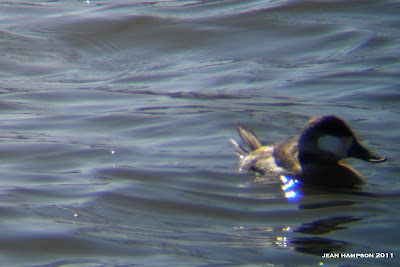In her duties as an agent with the local SPCA, Jean has witnessed a variety of animals brought into the shelter and when it's a bird, she is asked to put her identification skills to work. Once the bird is identified, given a health assessment and recorded for the Migratory Bird Act, it is released back to the environment.
At times, Jean also identifies invertebrates and on Monday April 11, a large insect found in the parking lot of a shopping mall was brought to the shelter by a member of the public. It was a Giant Water Bug. Jean determined that the bug was not injured and set it free into the still water of a nearby pond. When returning to her vehicle, Jean noticed some birds flitting in the trees. One of them was a Ruby-crowned Kinglet, a species we did not find during the BOS count the day before. Jean and I returned to the area the next evening and began our search for the kinglet along the Merritt Trail. We visit this section of the trail often but normally start at the Martindale Road entrance, especially during the winter months.
As we started our walk, we heard a Carolina Wren calling from the opposite side of 12 Mile Creek. We soon found kinglets of the Golden-crowned variety in a tangle of branches as we approached the pond.

Moments later, along with some chickadees, we found our FOY Ruby-crowned Kinglet. It was brief but it still counts. A robin-sized bird running through the brush also caught our attention. It was moving quickly and not standing in one spot for very long. Eventually, Jean and I had enough views to confirm we observed a Hermit Thrush, another first for 2011.
At the pond, we found an Eastern Phoebe and an animal that did not seem to be bothered by our presence.

A beaver was dining on some branches, less than 10 metres from the trail. This rodent species has returned to St. Catharines and is doing very well along the banks of 12 Mile Creek. Jean and I have observed Castor, many times while birding in this area of the city.


With Ruby-crowned Kinglet and Hermit Thrush safely added to the year list, it was time to turn our attention to a few Boreal species. Jean and I were set for the annual OFO trip in Algonquin Provincial Park and though we have never seen a beaver in the park, including hikes on the Beaver Pond Trail, we should have no problem ticking Spruce Grouse, a species successfully found on the trip for over 20 years. All we had to do was show up. It's as easy as that. Or is it?































